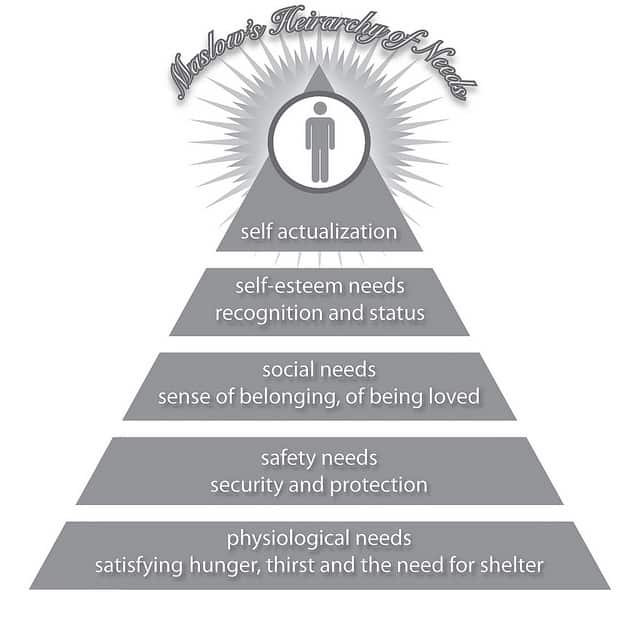Maslow’s Need Hierarchy Theory of Motivation
Abraham Maslow’s research was actually focused on human personality, and he suggested that people differ because they differ in their needs and motivation. This came to be known as a ‘third force’ in understanding the human psyche after Freud proposed that behavior can be explained by one’s unconscious desires and the second – behavioral view that behavior is determined by its consequences.
Maslow and his followers came to know as ‘humanists’ because of their stand that is natural for humans to want to grow and develop beyond the concern for survival. While survival is the need for all, not all the human effort is directed at it. There are more needs beyond survival and everyone can advance to higher levels of needs where one is sensitive to dimensions like harmony, beauty, justice, perfection and search for the true purpose of existence.
Thus, in Maslow’s need hierarchy, the top position went to the needs placed higher than the basic needs that were based on the ongoing cycle of deficiency and fulfillment. However, according to Maslow, the higher needs are different because they do not arise out of deficiency.
From this perception, he presented his hierarchy of needs. At the base of the hierarchy, he placed the psychological or basic needs, and from there onwards, the needs progressed towards the highest orders. The next was safety needs, representing the need for some kind of structure, order, safety, and security. Love and belongingness needs were placed next and Maslow took a position that even these were survival needs. When love needs are dominant, the individual looks for relations and intimacy desires to love and recognition from others.
Beyond love and belongingness, Maslow presented the esteem needs, which were actually divided into two parts. The lower esteem represents the need to be respected by others, achieve status, recognition from others, reputation and dominance. A higher form of esteem is self-esteem, which represents the need to develop self-respect, confidence, competence, and mastery.
Even esteem needs were grouped as ‘deficiency needs’ by Maslow because he believed that the inadequacy of any of these in an individual will push him/her towards their satisfaction and once they are satisfied, the person will still look for ’something higher’. As long as they are not satisfied, the individual will strive to fulfill them in order to ease the tension and imbalance created by their deficiency.
If an individual feels satisfied on all these levels, he would still search for the meaning of his existence and began to explore, discover and utilize his true or full potential. This phenomenon was termed by Maslow as the self-actualization need or ‘being need’, which he replaced as the highest in the need hierarchy. This is the need of a person to discover his true potential and once evoked, never stops growing.
The self-actualization person becomes autonomous and spontaneous in the sense that he does not blindly follow any culture or custom in order to gain acceptance or approval or under any compulsion. Those who fit Maslow’s description of self-actualized persons can examine reality without prejudice, be creative in solving problems, believe in democratic values, and accept self and others as they are.
Maslow’s theory intuitively appeals to practitioners and executives, though his theory is based on no formal research in management. Others also commented that his theory could not be of practical use to managers, as it merely classified the needs that everyone has.
The need hierarchy was later adapted to the work context from top to bottom.
Maslow’s Need Hierarchy Theory
Self-actualization Needs: These needs are found in those individuals whose previous four needs are fulfilled. This includes the desire to become what you are capable of becoming. Fulfillment generated by learning new skills, taking challenges, social service, gaining more knowledge, being aesthetic is some of the self-actualization needs.
Self Esteem Needs: These needs relate to the recognition of one’s achievements, self-respect, power, confidence, competence, status, attention, achievement, and freedom.
Social Needs: Man is a social animal. He needs love, affection, the feeling of belongingness from his family and friends, membership of groups and unions to fulfill his social needs.
Safety Needs: After psychological needs, comes safety needs which include job security, financial security, physical security, health security, family security and safety-driven by insurance, etc.
Physiological Needs: This includes the basic needs of an individual like food, shelter, clothes, air, water which a person needs to survive in this world. In short, psychological needs related to the survival and maintenance of human life.
Limitations of Maslow’s Hierarchy Theory
- The theory assumes that all people experience these needs in the same order, failing to recognize cultural and individual differences. In collectivist societies, for example, social needs may be considered more important than physiological needs.
- Maslow’s description of self-actualization and how self-actualized people felt and behaved, was based on writing and talking to selectively chosen people rather than rigorous sampling.
- Maslow restricted the number of self-actualized people in his theory. At one time, he wrote that less than two percent of the total population is made of self-actualizes.






